As CrossFit coaches, we often face the challenge and privilege of meeting athletes where they are and adapting the methodology to fit their unique needs. This case report shares the journey of Jaime, a 58-year-old athlete navigating life after a complete spinal cord injury at the C6-C7 level. It highlights the principles of adaptive training in action, from assessment and programming to progress tracking and community integration. Jaime’s story is a reminder that with the right approach, CrossFit is for anyone.
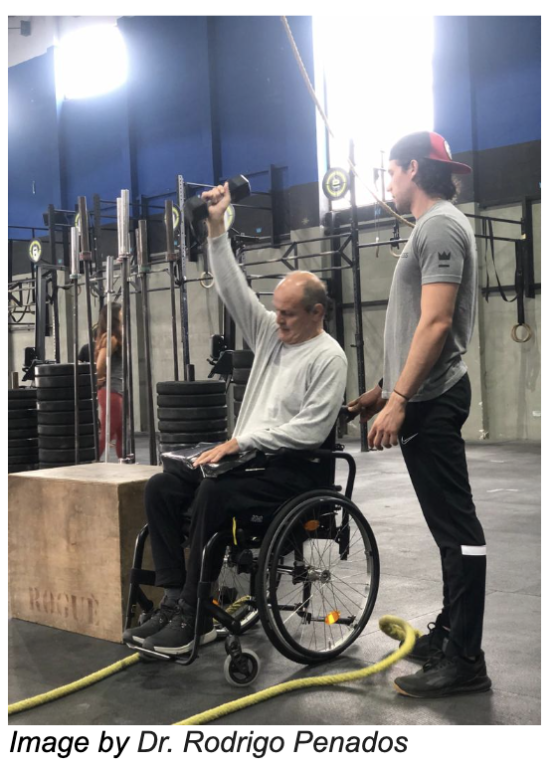 At the age of 58, Jaime suffered a complete spinal cord injury at the C6-C7 level. He was admitted to the critical care unit and stayed there for five weeks. After hospital medical treatment, he was discharged without a guided plan on the steps to follow. This meant a change in Jaime’s life and the people around him.
At the age of 58, Jaime suffered a complete spinal cord injury at the C6-C7 level. He was admitted to the critical care unit and stayed there for five weeks. After hospital medical treatment, he was discharged without a guided plan on the steps to follow. This meant a change in Jaime’s life and the people around him.
The rehabilitation process was slow for the first few months. The focus was on adapting to his new lifestyle and stabilizing his health. Some of the challenges were learning how to move around, looking for a wheelchair, and regulating his medications.
Jaime had the opportunity to travel to the Institut Guttman in Barcelona to undergo a 12-week intensive rehabilitation program where he saw a lot of progress. He returned to Guatemala motivated and eager to continue his rehabilitation program.
Day 0: Initial Approach with the Athlete
On Monday, Aug. 23, 2021, Jaime and I met. We talked about his life before the injury, lifestyle changes, medical history, progress in rehabilitation, day-to-day challenges, and short and long-term goals. Later, we discussed the general methodology of Adaptive Training and its principles of safety, effectiveness, and inclusiveness.
We performed a series of range-of-motion tests in different joints and planes, trunk stabilization control, and grip strength tests. We finished by testing the cardio machines (rower, air bike) in their adapted version.
Day 0 summary:
- Athlete’s history
- Presentation of methodology and basic principles of adapted programming
- Testing ranges of motion, strength, and intensity
- Taking notes and modifying the induction schedule according to the tests
Workout:
A. 2-min. row
*Rest 1 min
1-min. row
B. 2-min. bike
*Rest 1 min.
1-min. bike
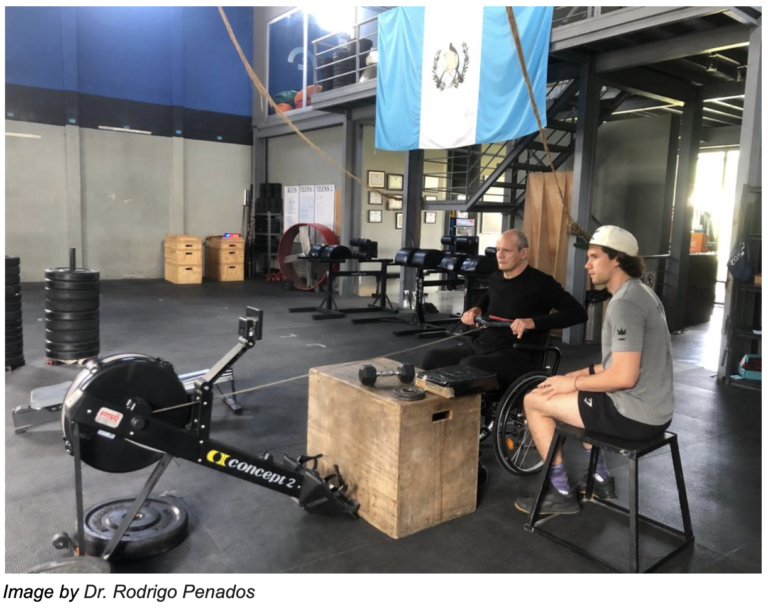
“Day 0” ended with the fulfillment of the introductory programming schedule. This programming is carried out based on the general competencies sought in the adapted athlete. The base is gaining functionality through avoiding pain, expanding the range of motion, and developing strength.
The schedule for the introduction stage is summarized in Table 1.
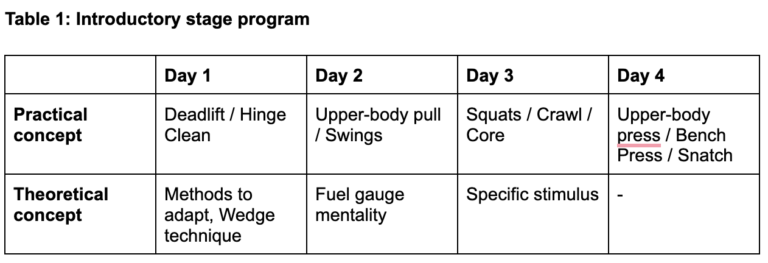
Day 1: Adaptive Training Methods. Wedge Technique and Hinge.
From day 0, it is essential to establish an empathetic connection with the athlete and his companions. It is suggested that during the first days of training, the athlete is accompanied by a person who regularly helps him carry out his activities. This helps obtain valuable aggregate information for programming and fitting.
On Day 1, we discussed the different methods to adapt a workout and the training modalities:
- Tasks accomplishments
- Functional movement templates
- Specific stimulus
It is fundamental to involve the athlete in this learning process so that in the future, he/she can modify the movements, tasks, and stimuli in collaboration with a coach.
The wedge technique is used as a method of teaching the movement pattern in Olympic lifting movements in seated-adapted athletes. The technique consists of elbow movement in three phases: back, down, and in front. This applies to carrying any object from the lap to the shoulders and/or above the head.
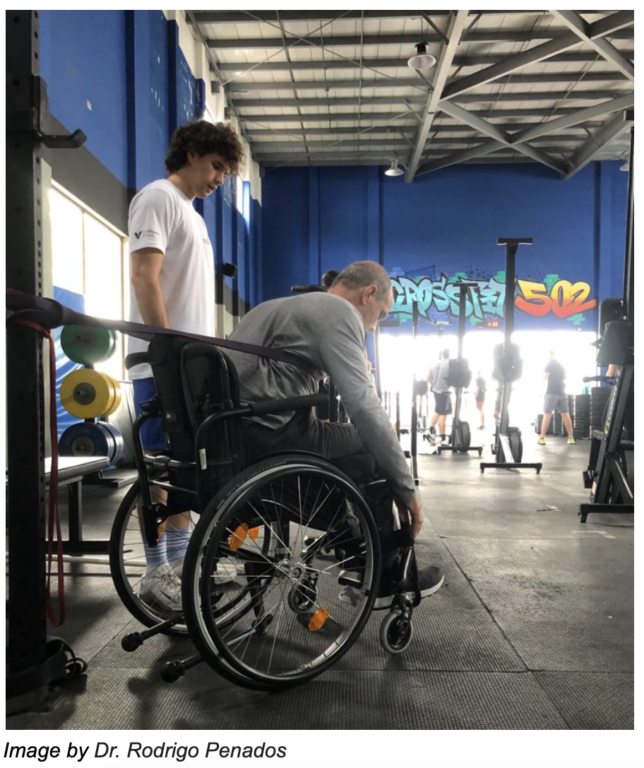 Day 1 summary:
Day 1 summary:
- Adaptive training methods and common training modalities
- Warm-up
- Hip function tests
- Clean drills: wedge technique
- Deadlift drills and variations
- Workout: Diane
Day 1 workout:
21-15-9
Double DB DL with band assistance
Double DB shoulder press
During the training session, the movements and variations were modified due to core stability and the range of motion on the rest of the limbs. The assistance with bands and extra support points were very helpful for the rapid progress of the movements. The bands also provided greater safety in the movements.
Day 2: Fuel Gauge Mentality. Upper-Body Pull.
We started day 2 with the concept of the fuel gauge mentality. Always be conscious of the principle of safety before effectiveness. It is essential to remind athletes to return to safe positions before reaching failure (mainly out-of-chair body pull movements).
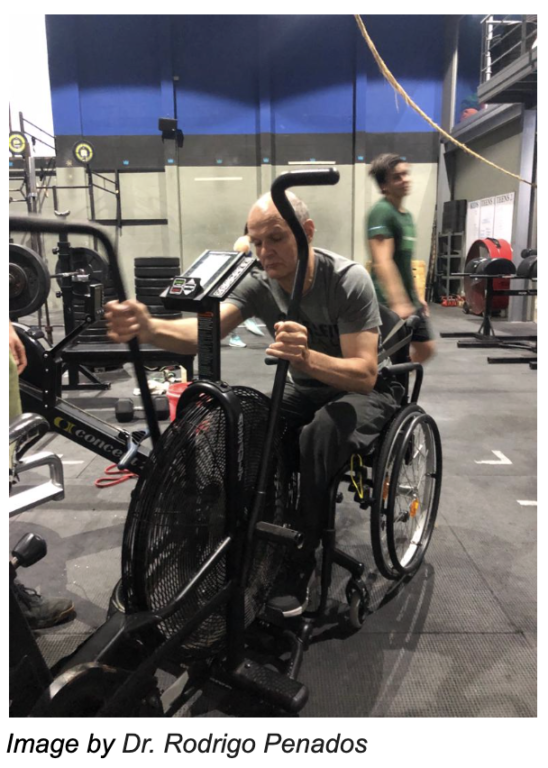 In the programming of seated adapted athletes, PULL> PRESS must be prioritized.
In the programming of seated adapted athletes, PULL> PRESS must be prioritized.
We performed pull variations on this day: band resistance pull-downs, sled pulls, and rope pulls. It was a good day to evaluate the strength and resistance of the grip. Thick grip objects posed a greater challenge and difficulty for the athlete than thinner grip points.
Day 2 summary:
- Fuel Gauge Mentality
- Warm-up, accessory work
- Grip and pull tests
- Swings drills
- Workout
Day 2 Workout:
As many rounds as possible in 15 minutes of:
10 banded pull-downs
10 KB swings (R/L)
1-min. air bike
Day 3: Out of the Wheelchair. Squats, Core, and Crawl
The training on Day 3 requires the athlete to perform exercises in, out, and with the chair. The aim is to generate adaptation and preparation for the challenges of daily life, like moving from the chair to the bed/car, picking up an object from the floor to the hips, moving things from one point to another, carrying objects above the head, etc.
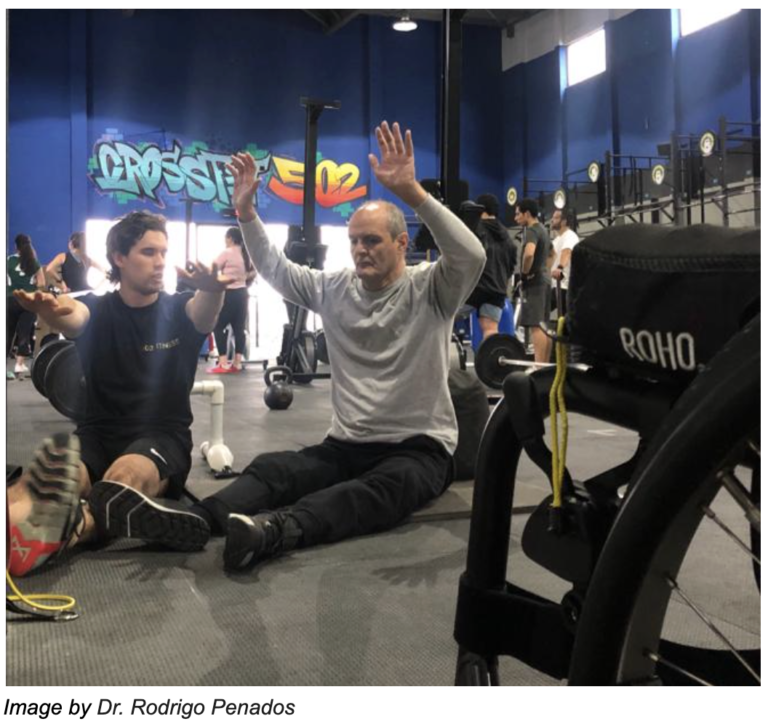 Day 3 was a great challenge regarding the organization of movements and variations. Mentioning that the athlete would do squats without having lower-body motor control created a shock. At that moment, we modified the movement based on the stimulus. A primary section of work when performing squats is core control/midline stabilization. Therefore, you can work on core stabilization exercises to adapt to squat exercises.
Day 3 was a great challenge regarding the organization of movements and variations. Mentioning that the athlete would do squats without having lower-body motor control created a shock. At that moment, we modified the movement based on the stimulus. A primary section of work when performing squats is core control/midline stabilization. Therefore, you can work on core stabilization exercises to adapt to squat exercises.
This is what we did with Jaime: Sitting on the floor, a posterior support point (we used a sandbag), with arms prone and extended, arms were moved in a superior direction to bring them to 90 degrees above the head. If the athlete cannot reach 90 degrees, lower the arms between 5-10 degrees where the instability of the core begins and then hold between 15-30 seconds. The test can be repeated for 5-6 sets. We achieved 20 seconds at a 45-degree angle. The same test can also be performed using an external load to add difficulty.
It is essential to work based on trial and error, having different variations prepared. If one does not work, you can go back or forward.
On this day, the help of Jaime’s companion was crucial, as she assisted in mobilization issues outside the chair and technique.
Day 3 summary:
- Specific stimulus
- Out-of-chair warm-up, accessory work
- Core stabilization tests
- Workout
Day 3 Workout:
Every minute on the minute for 10 minutes of:
Odd minutes:
5 bench presses
*Increasing weight
Even minutes: Rest
Day 4: Final Day. Upper-Body Press and Snatch
This was the last day of the introductory stage. We carried out press progressions and reviewed how to adapt when seeing able-body person workouts with strict press, push press, and jerk. We performed drills for the snatch with the wedge technique.
The session mainly focused on preparing for the workout. For this day, we selected a workout from the 2021 CrossFit Open, with high intensity and high demand for movement and skills.
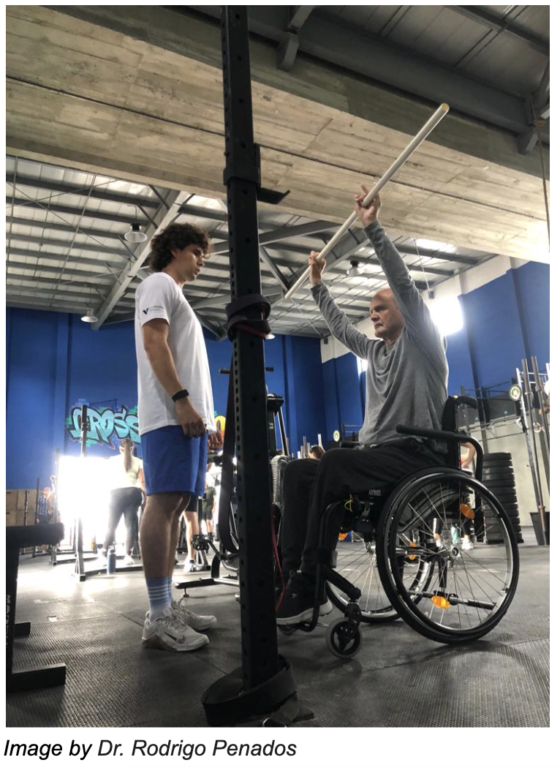 Day 4 Workout:
Day 4 Workout:
Workout 21.2: Adaptive – Seated Without Hip Function
For time:
10 lap DB snatches
15 chair U-turns
20 lap DB snatches
15 chair U-turns
30 lap DB snatches
15 chair U-turns
40 lap DB snatches
15 chair U-turns
50 lap DB snatches
15 chair U-turns
15-lb. dumbbell, 20 inches for U-turns
25-lb. dumbbell, 20 inches for U-turns
Time cap: 20 min.
We scaled the weight and the U-turn repetitions since it was the first day we worked on this movement. Jaime performed very well during the workout and finished at 13:36. We discussed individualized programming and participation in GPP classes with support from a coach for adaptation and assistance.
Discussion of Results: After the Introductory Stage
Positive results were obtained in the introductory stage. This first stage of work with the adapted athlete is extremely important since new movements are being worked on that pose new challenges. The level of motivation must be kept very high to connect this and the next stage of work.
The experience with Jaime was pleasant due to his high adaptability to movements and training methodology. Having had a great variety of movements and variations in workouts was vital for the tests that were not achieved.
I discussed two follow-up options with Jamie: individualized programming/personal training or regular classes with adapted modification. Jamie wanted to do a mix of both: GPP would be performed with the rest of the gym’s athletes (always with my support) and other days he would get personalized programming.
Discussion of Results: Two Months After Starting
The changes generated in a person are the sum of each individualized action. The improvement or deterioration of an athlete is the product of a multifactorial interaction. Therefore, they are not 100 percent attributable to a single cause.
I always start my discussion with athletes with this phrase since the progress achieved with an athlete constantly exposed to change cannot be attributed 100% to a cause (a coach, programming, diet, medicine, physiotherapist, doctor, spirituality, etc.) It is the sum of each action that generates a change.
During two months of working with Jaime, I saw him progress psychologically, physically, and socially. The psychological and social spheres have great clinical significance regarding physical performance. That is why scheduling should lead to improvement and progress and not constantly to failure, as this can lead to despair, frustration, and sadness.
Days of low mood tend to lean toward poor or low physical performance.
Jaime’s general mood has improved. Work sessions always began with a smile and body language that showed happiness. During our conversations unrelated to exercise or health topics, he expressed joy and a desire to keep moving forward. I noticed remarkable progress during the time we’ve been working together.
Providing personal training and opportunities for Jaime to attend regular group classes has had a positive impact on his physical and social performance. Motivational encouragement from fellow athletes provides great support to him as well.
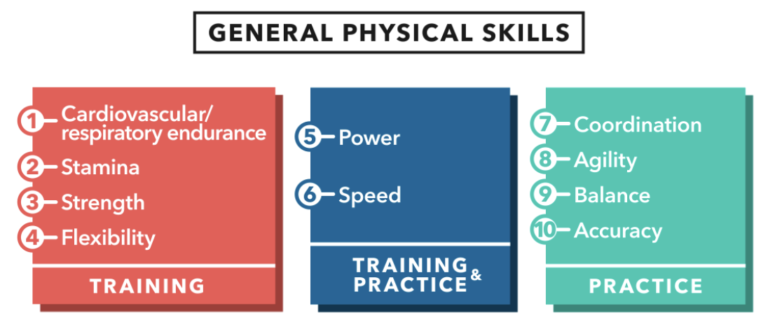
Based on the CrossFit definition of fitness, the most significant results Jamie had were in the following three general physical skills:
- Cardiovascular and respiratory resistance: In people with spinal cord injuries, cardiac output and physiological functions of regulating the cardiovascular system are modified and diminished, just like the total lung capacity. Therefore, adapting to this stimulus represents a greater challenge when working with it. With Jaime, great progress was made in terms of resistance in short, medium, and long workout durations. We primarily used the Assault Air Bike since it allows constant work without fatiguing other muscle groups.
- Coordination: Functional movements, which involve the activation of various joints, represent a much bigger task in execution. Initially, Jamie’s range of motion was limited and he didn’t achieve muscle activation in the expected order. Two months later, however, most of his joints have a range of motion close to 100%, and there is muscle activation in an orderly fashion.
- Balance: Since Day 0, balance and activation of the core posed a challenge since he has no motor control of his hip. After two months of repeating the core control, balance, and stability tests, Jaime managed to hold his trunk upright for +45 seconds with his arms extended at 80-85 degrees.
I look forward to continued work with Jamie and to take what I’ve learned as I coach more adaptive athletes in the future.
 Dr. Rodrigo Jose Penados Castro
Dr. Rodrigo Jose Penados Castro